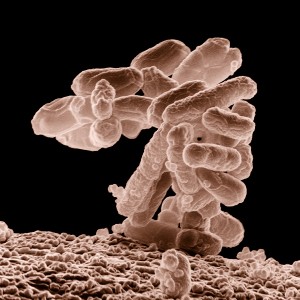
Georgia Tech researchers found many types of bacteria, include E.coli, in the middle to upper regions of the troposphere. (Photo: USDA)
Scientists have discovered a considerable number of living microorganisms, including bacteria, in the middle to upper regions of the troposphere, the region of our atmosphere that’s about seven to 20 kilometers above the Earth’s surface.
Researchers from the Georgia Institute of Technology said their findings might help other scientists learn more about the role microorganisms play in forming ice that may impact weather and climate.
Health and medical experts studying the transmission of disease could also benefit by gaining new insight into long-distance transport of bacteria.
Conditions in the troposphere cannot support most other forms of life without the aid of special equipment. Temperatures there can drop to as low as -55° C and the air pressure and density are considerably lower than on earth.
Microorganisms, such as bacteria, are plentiful and can be found everywhere on the Earth and in the sea.
These hardy little forms of life not only survive but actually thrive in some of the harshest conditions known to man. They live within other forms of life, such as the human body; in the soil and the air surrounding us; in scalding hot springs; the great depths of the ocean; and inside rocks deep within the Earth’s crust.

A view outside the window of a DC-8 aircraft as air samples are gathered for a NASA study. Georgia Tech scientists found living microorganisms in the samples. (Photo: NASA)
The microorganisms documented by Georgia Tech scientists were gathered from air samples recovered as part of NASA’s 2010 Genesis and Rapid Intensification Processes (GRIP) program, which studies low- and high-altitude air masses associated with tropical storms.
NASA gathered the air samples from aboard a DC-8 aircraft that flew over both land and ocean, including the Caribbean Sea and portions of the Atlantic Ocean during and after two major tropical hurricanes in 2010, Earl and Karl.
Attaching a special filter system developed by the Georgia Tech team to the aircraft’s outside air sampling probes, researchers were able to collect numerous particles, including the microorganisms.
Once the air samples were taken, the filters were removed from the aircraft and sent to researchers for examination.
Rather than resorting to conventional cell-culture techniques to make their analysis, the researchers instead used genomic techniques, including polymerase chain reaction (PCR) – a biochemical technology used in molecular biology that magnifies a piece of DNA, allowing scientists to generate millions of copies of the DNA sequence, as well as gene sequencing to spot and estimate the quantities of microorganisms contained within the air samples.
The researchers found more bacteria than fungi among the microorganisms.
“We did not expect to find so many microorganisms in the troposphere, which is considered a difficult environment for life,” said one of the study’s authors, Kostas Konstantinidis, an assistant professor at Georgia Tech. “There seems to be quite a diversity of species, but not all bacteria make it into the upper troposphere.”

Terry Lathem, a graduate student in Georgia Tech’s School of Earth and Atmospheric Sciences, aboard a NASA DC-8 aircraft while gathering samples of microorganisms in the atmosphere. (NASA)
The living bacterial cells found made up about 20 percent of the total particles detected within the size range of 0.25 to 1 microns in diameter.
Air samples taken over the ocean were found to contain mostly marine bacteria, while primarily terrestrial bacteria was found in samples taken above land.
The researchers also found that hurricanes had a major impact on the distribution and dynamics of microorganism populations.
Kostas Konstantinidis joins us for this weekend’s radio edition of Science World. He’ll tell us how these findings could help advance research in climatology and medicine.
Check out the right column for scheduled air-times or listen now to the interview below.
Audio clip: Adobe Flash Player (version 9 or above) is required to play this audio clip. Download the latest version here. You also need to have JavaScript enabled in your browser.




 Science World is VOA’s on-air and online magazine covering science, health, technology and the environment.
Science World is VOA’s on-air and online magazine covering science, health, technology and the environment.